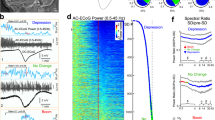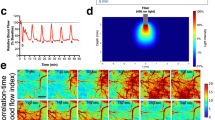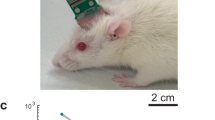Abstract
The term spreading depolarization describes a wave in the gray matter of the central nervous system characterized by swelling of neurons, distortion of dendritic spines, a large change of the slow electrical potential and silencing of brain electrical activity (spreading depression). In the clinic, unequivocal electrophysiological evidence now exists that spreading depolarizations occur abundantly in individuals with aneurismal subarachnoid hemorrhage, delayed ischemic stroke after subarachnoid hemorrhage, malignant hemispheric stroke, spontaneous intracerebral hemorrhage or traumatic brain injury. Spreading depolarization is induced experimentally by various noxious conditions including chemicals such as potassium, glutamate, inhibitors of the sodium pump, status epilepticus, hypoxia, hypoglycemia and ischemia, but it can can also invade healthy, naive tissue. Resistance vessels respond to it with tone alterations, causing either transient hyperperfusion (physiological hemodynamic response) in healthy tissue or severe hypoperfusion (inverse hemodynamic response, or spreading ischemia) in tissue at risk for progressive damage, which contributes to lesion progression. Therapies that target spreading depolarization or the inverse hemodynamic response may potentially treat these neurological conditions.
This is a preview of subscription content, access via your institution
Access options
Subscribe to this journal
Receive 12 print issues and online access
$209.00 per year
only $17.42 per issue
Buy this article
- Purchase on Springer Link
- Instant access to full article PDF
Prices may be subject to local taxes which are calculated during checkout




Similar content being viewed by others
References
Alle, H., Roth, A. & Geiger, J.R. Energy-efficient action potentials in hippocampal mossy fibers. Science 325, 1405–1408 (2009).
Rolfe, D.F. & Brown, G.C. Cellular energy utilization and molecular origin of standard metabolic rate in mammals. Physiol. Rev. 77, 731–758 (1997).
Kraig, R.P. & Nicholson, C. Extracellular ionic variations during spreading depression. Neuroscience 3, 1045–1059 (1978).
Canals, S. et al. Longitudinal depolarization gradients along the somatodendritic axis of CA1 pyramidal cells: a novel feature of spreading depression. J. Neurophysiol. 94, 943–951 (2005).
Leão, A.A.P. Spreading depression of activity in the cerebral cortex. J. Neurophysiol. 7, 359–390 (1944).
Takano, T. et al. Cortical spreading depression causes and coincides with tissue hypoxia. Nat. Neurosci. 10, 754–762 (2007).
Kager, H., Wadman, W.J. & Somjen, G.G. Conditions for the triggering of spreading depression studied with computer simulations. J. Neurophysiol. 88, 2700–2712 (2002).
Leão, A.A.P. Further observations on the spreading depression of activity in the cerebral cortex. J. Neurophysiol. 10, 409–414 (1947).
Lauritzen, M. Pathophysiology of the migraine aura. The spreading depression theory. Brain 117, 199–210 (1994).
Somjen, G.G. Ions in the Brain. (Oxford University Press, Oxford, UK, 2004).
Largo, C., Cuevas, P., Somjen, G.G., Martin del Rio, R. & Herreras, O. The effect of depressing glial function in rat brain in situ on ion homeostasis, synaptic transmission and neuron survival. J. Neurosci. 16, 1219–1229 (1996).
van den Maagdenberg, A.M. et al. A Cacna1a knockin migraine mouse model with increased susceptibility to cortical spreading depression. Neuron 41, 701–710 (2004).
De Fusco, M. et al. Haploinsufficiency of ATP1A2 encoding the Na+/K+ pump α2 subunit associated with familial hemiplegic migraine type 2. Nat. Genet. 33, 192–196 (2003).
Rossi, D.J., Oshima, T. & Attwell, D. Glutamate release in severe brain ischaemia is mainly by reversed uptake. Nature 403, 316–321 (2000).
Attwell, D. & Iadecola, C. The neural basis of functional brain imaging signals. Trends Neurosci. 25, 621–625 (2002).
Koehler, R.C., Roman, R.J. & Harder, D.R. Astrocytes and the regulation of cerebral blood flow. Trends Neurosci. 32, 160–169 (2009).
Lauritzen, M., Hansen, A.J., Kronborg, D. & Wieloch, T. Cortical spreading depression is associated with arachidonic acid accumulation and preservation of energy charge. J. Cereb. Blood Flow Metab. 10, 115–122 (1990).
Windmüller, O. et al. Ion changes in spreading ischaemia induce rat middle cerebral artery constriction in the absence of NO. Brain 128, 2042–2051 (2005).
Piilgaard, H. & Lauritzen, M. Persistent increase in oxygen consumption and impaired neurovascular coupling after spreading depression in rat neocortex. J. Cereb. Blood Flow Metab. 29, 1517–1527 (2009).
Mutch, W.A. & Hansen, A.J. Extracellular pH changes during spreading depression and cerebral ischemia: mechanisms of brain pH regulation. J. Cereb. Blood Flow Metab. 4, 17–27 (1984).
Heinemann, U. & Lux, H.D. Ceiling of stimulus induced rises in extracellular potassium concentration in the cerebral cortex of cat. Brain Res. 120, 231–249 (1977).
Hossmann, K.A. Viability thresholds and the penumbra of focal ischemia. Ann. Neurol. 36, 557–565 (1994).
Dietz, R.M., Weiss, J.H. & Shuttleworth, C.W. Zn2+ influx is critical for some forms of spreading depression in brain slices. J. Neurosci. 28, 8014–8024 (2008).
Czéh, G., Aitken, P.G. & Somjen, G.G. Membrane currents in CA1 pyramidal cells during spreading depression (SD) and SD-like hypoxic depolarization. Brain Res. 632, 195–208 (1993).
Jing, J., Aitken, P.G. & Somjen, G.G. Interstitial volume changes during spreading depression (SD) and SD-like hypoxic depolarization in hippocampal tissue slices. J. Neurophysiol. 71, 2548–2551 (1994).
Aitken, P.G., Tombaugh, G.C., Turner, D.A. & Somjen, G.G. Similar propagation of SD and hypoxic SD-like depolarization in rat hippocampus recorded optically and electrically. J. Neurophysiol. 80, 1514–1521 (1998).
LaManna, J.C. & Rosenthal, M. Effect of ouabain and phenobarbital on oxidative metabolic activity associated with spreading cortical depression in cats. Brain Res. 88, 145–149 (1975).
Farkas, E., Bari, F. & Obrenovitch, T.P. Multi-modal imaging of anoxic depolarization and hemodynamic changes induced by cardiac arrest in the rat cerebral cortex. Neuroimage 51, 734–742 (2010).
Oliveira-Ferreira, A.I. et al. Experimental and preliminary clinical evidence of an ischemic zone with prolonged negative DC shifts surrounded by a normally perfused tissue belt with persistent electrocorticographic depression. J. Cereb. Blood Flow Metab. 30, 1504–1519 (2010).
Nozari, A. et al. Microemboli may link spreading depression, migraine aura and patent foramen ovale. Ann. Neurol. 67, 221–229 (2010).
Nedergaard, M. & Hansen, A.J. Spreading depression is not associated with neuronal injury in the normal brain. Brain Res. 449, 395–398 (1988).
Saito, R. et al. Reduction of infarct volume by halothane: effect on cerebral blood flow or perifocal spreading depression-like depolarizations. J. Cereb. Blood Flow Metab. 17, 857–864 (1997).
Mies, G., Iijima, T. & Hossmann, K.A. Correlation between peri-infarct DC shifts and ischaemic neuronal damage in rat. Neuroreport 4, 709–711 (1993).
Dijkhuizen, R.M. et al. Correlation between tissue depolarizations and damage in focal ischemic rat brain. Brain Res. 840, 194–205 (1999).
Hartings, J.A., Rolli, M.L., Lu, X.C. & Tortella, F.C. Delayed secondary phase of peri-infarct depolarizations after focal cerebral ischemia: relation to infarct growth and neuroprotection. J. Neurosci. 23, 11602–11610 (2003).
Takano, K. et al. The role of spreading depression in focal ischemia evaluated by diffusion mapping. Ann. Neurol. 39, 308–318 (1996).
Charriaut-Marlangue, C. et al. Apoptosis and necrosis after reversible focal ischemia: an in situ DNA fragmentation analysis. J. Cereb. Blood Flow Metab. 16, 186–194 (1996).
Richter, F., Bauer, R., Lehmenkuhler, A. & Schaible, H.G. Spreading depression in the brainstem of the adult rat: electrophysiological parameters and influences on regional brainstem blood flow. J. Cereb. Blood Flow Metab. 28, 984–994 (2008).
Young, J.N., Aitken, P.G. & Somjen, G.G. Calcium, magnesium and long-term recovery from hypoxia in hippocampal tissue slices. Brain Res. 548, 343–345 (1991).
Dreier, J.P. et al. Nitric oxide scavenging by hemoglobin or nitric oxide synthase inhibition by N-nitro-L-arginine induces cortical spreading ischemia when K+ is increased in the subarachnoid space. J. Cereb. Blood Flow Metab. 18, 978–990 (1998).
Leão, A.A.P. & Morison, R.S. Propagation of spreading cortical depression. J. Neurophysiol. 8, 33–45 (1945).
Headache Classification Subcommittee of the International Headache Society. The International Classification of Headache Disorders: 2nd ed. Cephalalgia 24 Suppl 1, 9–160 (2004).
Hadjikhani, N. et al. Mechanisms of migraine aura revealed by functional MRI in human visual cortex. Proc. Natl. Acad. Sci. USA 98, 4687–4692 (2001).
Martins-Ferreira, H., Nedergaard, M. & Nicholson, C. Perspectives on spreading depression. Brain Res. Brain Res. Rev. 32, 215–234 (2000).
Fleidervish, I.A., Gebhardt, C., Astman, N., Gutnick, M.J. & Heinemann, U. Enhanced spontaneous transmitter release is the earliest consequence of neocortical hypoxia that can explain the disruption of normal circuit function. J. Neurosci. 21, 4600–4608 (2001).
Erdemli, G., Xu, Y.Z. & Krnjevic, K. Potassium conductance causing hyperpolarization of CA1 hippocampal neurons during hypoxia. J. Neurophysiol. 80, 2378–2390 (1998).
Dreier, J.P. et al. Products of hemolysis in the subarachnoid space inducing spreading ischemia in the cortex and focal necrosis in rats: a model for delayed ischemic neurological deficits after subarachnoid hemorrhage? J. Neurosurg. 93, 658–666 (2000).
Iadecola, C., Zhang, F. & Xu, X. SIN-1 reverses attenuation of hypercapnic cerebrovasodilation by nitric oxide synthase inhibitors. Am. J. Physiol. 267, R228–R235 (1994).
Golding, E.M., Steenberg, M.L., Johnson, T.D. & Bryan, R.M. Nitric oxide in the potassium-induced response of the rat middle cerebral artery: a possible permissive role. Brain Res. 889, 98–104 (2001).
Mulligan, S.J. & MacVicar, B.A. Calcium transients in astrocyte endfeet cause cerebrovascular constrictions. Nature 431, 195–199 (2004).
Dreier, J.P. et al. Ischemia triggered by red blood cell products in the subarachnoid space is inhibited by nimodipine administration or moderate volume expansion/hemodilution in rats. Neurosurgery 51, 1457–1465 (2002).
Sukhotinsky, I., Dilekoz, E., Moskowitz, M.A. & Ayata, C. Hypoxia and hypotension transform the blood flow response to cortical spreading depression from hyperemia into hypoperfusion in the rat. J. Cereb. Blood Flow Metab. 28, 1369–1376 (2008).
Dreier, J.P. et al. Cortical spreading ischaemia is a novel process involved in ischaemic damage in patients with aneurysmal subarachnoid haemorrhage. Brain 132, 1866–1881 (2009).
Henrich, J.B., Sandercock, P.A., Warlow, C.P. & Jones, L.N. Stroke and migraine in the Oxfordshire Community Stroke Project. J. Neurol. 233, 257–262 (1986).
Knierim, E. et al. Recurrent stroke due to a novel voltage sensor mutation in Cav2.1 responds to verapamil. Stroke 2011, e14–e17 (2011).
Macdonald, R.L., Pluta, R.M. & Zhang, J.H. Cerebral vasospasm after subarachnoid hemorrhage: the emerging revolution. Nat. Clin. Pract. Neurol. 3, 256–263 (2007).
van Gijn, J. & Rinkel, G.J. Subarachnoid haemorrhage: diagnosis, causes and management. Brain 124, 249–278 (2001).
Shin, H.K. et al. Vasoconstrictive neurovascular coupling during focal ischemic depolarizations. J. Cereb. Blood Flow Metab. 26, 1018–1030 (2006).
Strong, A.J. et al. Peri-infarct depolarizations lead to loss of perfusion in ischaemic gyrencephalic cerebral cortex. Brain 130, 995–1008 (2007).
Strong, A.J. et al. Spreading and synchronous depressions of cortical activity in acutely injured human brain. Stroke 33, 2738–2743 (2002).
Dreier, J.P. et al. Delayed ischaemic neurological deficits after subarachnoid haemorrhage are associated with clusters of spreading depolarizations. Brain 129, 3224–3237 (2006).
Fabricius, M. et al. Cortical spreading depression and peri-infarct depolarization in acutely injured human cerebral cortex. Brain 129, 778–790 (2006).
Dohmen, C. et al. Spreading depolarizations occur in human ischemic stroke with high incidence. Ann. Neurol. 63, 720–728 (2008).
Sramka, M., Brozek, G., Bures, J. & Nadvornik, P. Functional ablation by spreading depression: possible use in human stereotactic neurosurgery. Appl. Neurophysiol. 40, 48–61 (1977).
Olesen, J., Larsen, B. & Lauritzen, M. Focal hyperemia followed by spreading oligemia and impaired activation of rCBF in classic migraine. Ann. Neurol. 9, 344–352 (1981).
Woods, R.P., Iacoboni, M. & Mazziotta, J.C. Brief report: bilateral spreading cerebral hypoperfusion during spontaneous migraine headache. N. Engl. J. Med. 331, 1689–1692 (1994).
Avoli, M. et al. Epileptiform activity induced by low extracellular magnesium in the human cortex maintained in vitro. Ann. Neurol. 30, 589–596 (1991).
Mayevsky, A. et al. Cortical spreading depression recorded from the human brain using a multiparametric monitoring system. Brain Res. 740, 268–274 (1996).
Parkin, M. et al. Dynamic changes in brain glucose and lactate in pericontusional areas of the human cerebral cortex, monitored with rapid sampling on-line microdialysis: relationship with depolarisation-like events. J. Cereb. Blood Flow Metab. 25, 402–413 (2005).
Fabricius, M. et al. Association of seizures with cortical spreading depression and peri-infarct depolarisations in the acutely injured human brain. Clin. Neurophysiol. 119, 1973–1984 (2008).
Sakowitz, O.W. et al. Preliminary evidence that ketamine inhibits spreading depolarizations in acute human brain injury. Stroke 40, e519–e522 (2009).
Hartings, J.A. et al. Spreading depolarizations and late secondary insults after traumatic brain injury. J. Neurotrauma 26, 1857–1866 (2009).
Lo, E.H. A new penumbra: transitioning from injury into repair after stroke. Nat. Med. 14, 497–500 (2008).
Aitken, P.G., Balestrino, M. & Somjen, G.G. NMDA antagonists: lack of protective effect against hypoxic damage in CA1 region of hippocampal slices. Neurosci. Lett. 89, 187–192 (1988).
Sasaki, T. et al. Dynamic changes in cortical NADH fluorescence in rat focal ischemia: evaluation of the effects of hypothermia on propagation of peri-infarct depolarization by temporal and spatial analysis. Neurosci. Lett. 449, 61–65 (2009).
Matsushima, K., Hogan, M.J. & Hakim, A.M. Cortical spreading depression protects against subsequent focal cerebral ischemia in rats. J. Cereb. Blood Flow Metab. 16, 221–226 (1996).
Yanamoto, H. et al. Induced spreading depression activates persistent neurogenesis in the subventricular zone, generating cells with markers for divided and early committed neurons in the caudate putamen and cortex. Stroke 36, 1544–1550 (2005).
Thompson, R.J., Zhou, N. & MacVicar, B.A. Ischemia opens neuronal gap junction hemichannels. Science 312, 924–927 (2006).
Meisel, C., Schwab, J.M., Prass, K., Meisel, A. & Dirnagl, U. Central nervous system injury-induced immune deficiency syndrome. Nat. Rev. Neurosci. 6, 775–786 (2005).
Naidech, A.M. et al. Cardiac troponin elevation, cardiovascular morbidity, and outcome after subarachnoid hemorrhage. Circulation 112, 2851–2856 (2005).
Xiong, Z.G. et al. Neuroprotection in ischemia: blocking calcium-permeable acid-sensing ion channels. Cell 118, 687–698 (2004).
Acknowledgements
Supported by grants of the Deutsche Forschungsgemeinschaft (DFG DR 323/2-2, 323/3-1, 323/5-1, SFB Tr3 D10), the Bundesministerium für Bildung und Forschung (Center for Stroke Research Berlin, 01 EO 0801), Bernstein Center for Computational Neuroscience Berlin 01GQ1001C B2 and the Kompetenznetz Schlaganfall. I would like to thank C. Reiffurth and S. Major for help with the figures.
Author information
Authors and Affiliations
Corresponding author
Ethics declarations
Competing interests
The author declares no competing financial interests.
Rights and permissions
About this article
Cite this article
Dreier, J. The role of spreading depression, spreading depolarization and spreading ischemia in neurological disease. Nat Med 17, 439–447 (2011). https://doi.org/10.1038/nm.2333
Published:
Issue Date:
DOI: https://doi.org/10.1038/nm.2333
This article is cited by
-
High-density cortical µECoG arrays concurrently track spreading depolarizations and long-term evolution of stroke in awake rats
Communications Biology (2024)
-
Delayed Deterioration of Electroencephalogram in Patients with Cardiac Arrest: A Cohort Study
Neurocritical Care (2024)
-
Mechanisms of initiation of cortical spreading depression
The Journal of Headache and Pain (2023)
-
Synaptic modifications transform neural networks to function without oxygen
BMC Biology (2023)
-
Noninvasive and reliable automated detection of spreading depolarization in severe traumatic brain injury using scalp EEG
Communications Medicine (2023)



